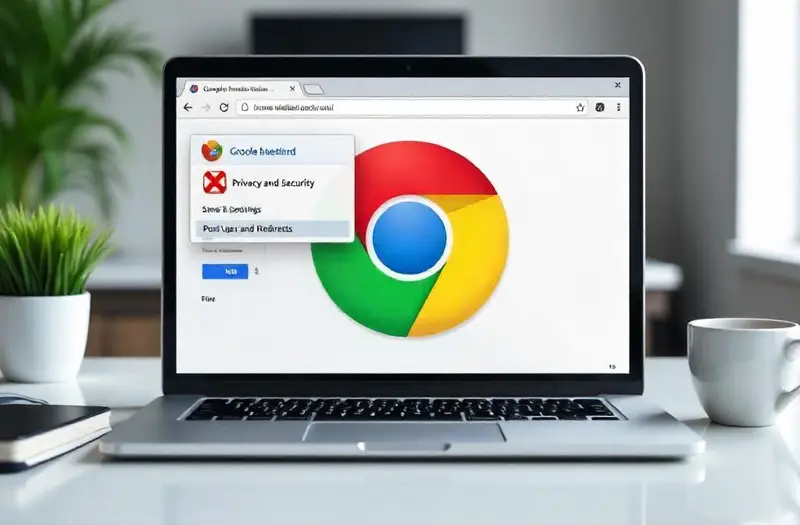Table of Contents
ToggleWhy Pop-Ups Appear on Chrome
Despite Chrome’s built-in pop-up blocker, we may still see unwanted ads due to malicious extensions, notification permissions, or poorly configured settings. Understanding where these pop-ups originate helps us better prevent them.
1. Legitimate vs. Malicious Pop-Ups
Some websites use pop-ups for necessary functions like login screens or notifications. However, malicious pop-ups often disguise themselves as warnings or “free prize” offers.
- Legitimate pop-ups: Often triggered by user interaction and generally allowed by Chrome.
- Malicious pop-ups: Auto-open without user input, sometimes redirecting to phishing or scam sites.
2. Sources of Pop-Up Ads
Unwanted pop-ups generally come from:
- Overly permissive Chrome notification settings
- Untrusted websites with intrusive ad behavior
- Browser extensions or plug-ins with adware code
3. Chrome’s Role in Pop-Up Display
By default, Chrome blocks pop-ups, but exceptions may allow some through. Keeping Chrome up to date helps reduce vulnerability to exploit-based pop-ups.
Fact: According to StatCounter, Chrome holds over 64.5% of the global browser market share as of 2025—making it a major target for pop-up-driven ads.
How to Use Chrome’s Built-In Pop-Up Blocker
Chrome comes with built-in tools to help us block pop ups Chrome without installing third-party software.
1. Accessing Site Settings
Go to:
- Chrome Menu (three dots at the top-right)
- Settings → Privacy and Security → Site Settings
- Scroll to “Pop-ups and redirects”
2. Blocking All Pop-Ups by Default
- Choose “Don’t allow sites to send pop-ups or use redirects.”
- This is the most effective method for enabling chrome pop up prevention natively.
3. Managing Exceptions
If certain sites still show pop-ups:
- Remove them from the Allow list in the same section
- Click the trash can icon to delete the exception
Tip: Always double-check if a trusted website genuinely requires pop-ups before adding it as an exception.
Disable Pop Up Notifications Chrome (Notifications vs. Ads)
Notification pop-ups are often confused with ad pop-ups. Chrome allows websites to send push notifications, and these can become invasive over time.
1. Navigate to Notification Settings
Go to:
- Chrome Settings → Site Settings → Notifications
2. Block All or Specific Sites
- Toggle “Don’t allow sites to send notifications” to globally block them
- Alternatively, block individual sites from the “Allowed to send notifications” list
3. Understand the Difference
- Notifications: Sent through Chrome even when you’re not on the site
- Pop-ups: Open new browser windows or tabs
Bold move: Turning off notifications drastically reduces spam-like interruptions.
Eliminate Pop Up Ads Chrome Using Extensions
If Chrome’s default settings aren’t enough, chrome pop up ad blocker extensions provide an additional layer of protection.
1. Trusted Pop-Up Blocker Extensions
Some of the most recommended extensions include:
- uBlock Origin
- AdBlock Plus
- Poper Blocker
2. Installation Process
- Visit the Chrome Web Store
- Search and install one of the above
- Enable permissions and configure settings
3. Monitoring Extension Activity
Some extensions can go rogue. Make sure you:
- Regularly check permissions
- Avoid lesser-known or recently launched ad blockers
- Update extensions frequently
“Using a trusted ad-blocking extension is like adding a second lock on your browser’s door.”
How to Stop Pop Ups Chrome on Mobile Devices
We often neglect mobile settings, but disable pop up ads Google Chrome on Android or iOS is just as important.
1. Android
- Open Chrome → Settings → Site settings
- Tap “Pop-ups and redirects” and ensure it’s set to blocked
- Also check “Ads” and “Notifications” for similar restrictions
2. iOS
- iOS Chrome has fewer options, but turning off JavaScript can help in extreme cases:
- Settings → Content Settings → JavaScript → Block
3. Use of Third-Party Browsers
Some mobile users opt for browsers like Brave or Firefox Focus with native ad blocking.
Data Point: Google reported in 2024 that mobile ad click-through rates dropped by 32% after widespread implementation of in-browser ad blockers.
Chrome Settings to Block Pop Ups from Specific Sites
Sometimes only certain websites are problematic. Here’s how to target them.
1. Open Chrome’s “Lock” Icon Menu
- Visit the site causing pop-ups
- Click the lock icon in the address bar
- Navigate to “Site settings”
2. Disable Permissions
- Block Pop-ups, Ads, and Notifications for this specific site
- Refresh the page to apply
3. Save Preferences
Chrome remembers your site settings, reducing the need to repeat this step.
Bonus: You can manage all site settings from chrome://settings/content/all.
Chrome Disable Pop Up Windows via Group Policies (For Enterprises)
For organizational use or shared systems, we can use Chrome group policies to enforce pop-up prevention.
1. Using Windows Group Policy Editor
- Access
gpedit.msc - Navigate to User Configuration > Administrative Templates > Google > Google Chrome > Content Settings
- Set “Pop-ups” to “Do not allow any site”
2. JSON Configuration for Admins
- Modify Chrome’s Managed Preferences file
- Add rule:
"PopupsAllowed": [],
"PopupsBlocked": ["*"]
3. Why It Works
Administrators can centrally enforce disable unwanted pop ups Chrome and prevent bypass by users.
Enterprise Insight: According to Cloudflare’s 2024 Cybersecurity Survey, 68% of IT teams rely on browser policies to manage web threats.
Chrome Pop Up Ads Removal Through Malware Scan
Pop-ups that persist despite all settings may be caused by malware.
1. Run Chrome’s Built-In Cleanup Tool (Windows Only)
- Go to: chrome://settings → Reset and clean up
- Select “Clean up computer”
- Run the scan
2. Use a Third-Party Antivirus
Recommended software includes:
- Malwarebytes
- Bitdefender
- Kaspersky
3. Restore Chrome Defaults
Resetting Chrome can eliminate deep-seated issues:
- Go to: Settings → Reset and Clean Up → Restore settings to their original defaults
Reminder: Resetting will delete site settings and disable extensions.
Chrome Pop Up Blocker Settings vs. Ad Blockers
There’s a difference between chrome pop up blocker settings and full-scale ad blockers.
1. Pop-Up Blocker
- Built into Chrome
- Targets window-based ads
- Best for general web use
2. Ad Blockers
- Third-party tools
- Also block banner ads, video pre-rolls, and trackers
- More comprehensive
3. Combining Both
Using both tools together maximizes our defense. Chrome disables pop up ads, while extensions eliminate broader ad types.
Disable Intrusive Pop Ups Chrome When Streaming or Gaming
If pop-ups interfere with platforms like Twitch, Netflix, or Steam, they might be browser-related.
1. Use Incognito Mode
- Launch Chrome in incognito mode
- This disables extensions and cached settings
2. Disable Overlays
- Some extensions inject overlay ads
- Disable all extensions, then re-enable one-by-one
3. Clean Browser Cache
- Go to: Settings → Privacy and Security → Clear browsing data
- Select Cached images and files, Cookies
Pro Tip: Use Ctrl+Shift+N to open a fresh incognito session instantly.
Disable Pop Up Ads Google Chrome in Safe Mode
Safe Mode testing helps identify if the pop-ups come from Chrome or another application.
1. Windows Safe Mode with Networking
- Restart PC → Press F8 → Select “Safe Mode with Networking”
- Launch Chrome and observe behavior
2. Mac Safe Boot
- Restart Mac → Hold Shift
- Open Chrome to test
3. Interpretation
If pop-ups stop in Safe Mode, a background application is the cause—often adware or rogue software.
Block Unwanted Pop Ups Chrome by Changing DNS
DNS-based blockers can prevent ad networks from resolving.
1. Use Privacy-Focused DNS Providers
- Cloudflare DNS (1.1.1.1)
- AdGuard DNS (94.140.14.14)
2. Modify Network Settings
- Go to Network settings → Change adapter options
- Update IPv4 DNS entries
3. Result
This helps prevent eliminate pop up ads Chrome before they load.
Disable Pop Ups Chrome with Parental Controls
Families can set restrictions to protect children or elderly users from pop-up content.
1. Use Family Link (Google)
- Create a supervised account
- Limit Chrome permissions and site access
2. Use Router-Level Blocking
- Configure router to block known ad domains
- Use tools like OpenDNS or CleanBrowsing
3. Educational Benefit
Reducing pop-ups improves focus and safety, especially for remote learners or senior citizens.
Create Custom Chrome Profiles Without Pop Ups
Profiles can isolate pop-up behavior.
1. Add a New Profile
- Chrome Menu → Settings → You and Google → Add new profile
2. Isolate Settings
- Configure chrome disable pop up ads only for that profile
- Use it for sensitive tasks like banking
3. Sync or No-Sync
Choose whether to sync bookmarks and extensions. No sync = less intrusion.
Process Table: Disable Pop-Up Ads on Chrome
| Step | Device Type | Method | Description |
|---|---|---|---|
| 1 | All | Chrome Settings | Block pop-ups and notifications manually |
| 2 | All | Use Extensions | Add verified ad blockers like uBlock Origin |
| 3 | Windows | Chrome Cleanup | Remove malware or adware |
| 4 | Mobile | Site Settings | Disable pop-ups per website |
| 5 | Enterprise | Group Policies | Centrally block pop-ups for all users |
| 6 | All | DNS/Router Settings | Preemptively block ad domains |
FAQs
How to disable pop up ads on Chrome completely?
Use Chrome’s site settings to block all pop-ups and redirects, and install a trusted pop-up blocker extension.
Can I stop pop-up ads on mobile Chrome?
Yes. On Android, go to Chrome Settings → Site Settings → Pop-ups and block them.
Are Chrome pop-ups dangerous?
Many are harmless, but some may contain malicious scripts or phishing links. Always be cautious.
What’s the best Chrome pop-up ad blocker?
uBlock Origin and AdBlock Plus are consistently top-rated for effectiveness and low memory usage.
Do I need antivirus to block pop-up ads?
Not necessarily, but antivirus tools help in cases where pop-ups are caused by malware or adware.
Conclusion
We’ve explored the full range of strategies for how to disable pop up ads on Chrome—from tweaking built-in settings to using DNS blocks and enterprise policies. Whether you’re working from a personal laptop, managing a team, or safeguarding your children’s online activity, the tools and tips in this guide ensure a cleaner, faster, and safer browsing experience. Keep Chrome updated, audit your extensions, and always be wary of sites requesting excessive permissions.
Key Takeaways
- Use Chrome’s pop-up and notification settings for basic ad blocking.
- Enhance protection with trusted ad-blocking extensions like uBlock Origin.
- Regularly scan for malware to remove hidden adware.
- Leverage DNS-level blocking and router settings for home-wide control.
- Create custom Chrome profiles for isolated, secure browsing experiences.
















